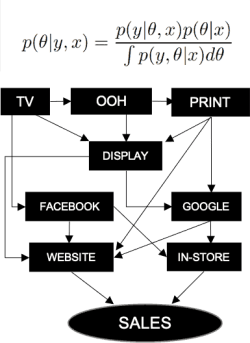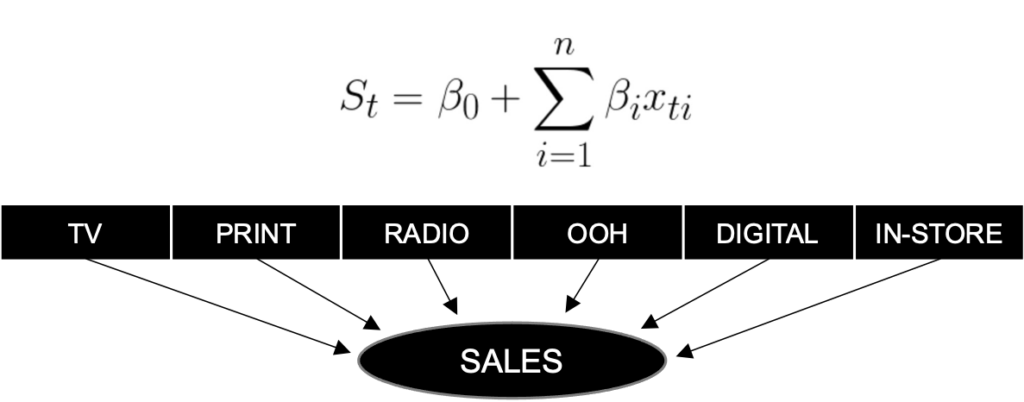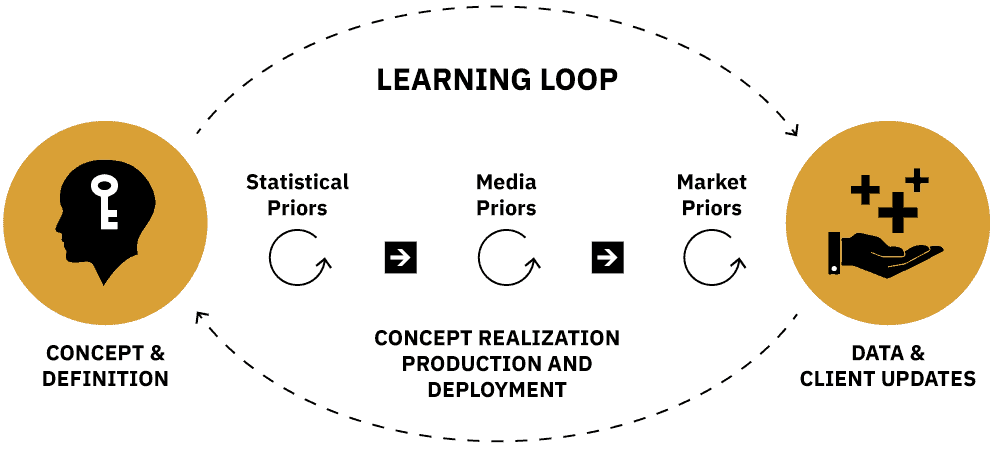Next generation of Marketing Mix Modeling
HamiltonAI is an AI-driven Marketing Analytics and Media Optimization Platform. Once loaded with the right data HamiltonAI enables scalability in deployment of many models simultaneously and rapidly. Each model builds upon learnings from hundreds of previously developed models, contributing to the improvement of the general modeling framework.
Bayesian Marketing Mix Modeling

The Unified Marketing Measurement and Optimization platform, HamiltonAI, is not only a marketing attribution software but a modeling engine, based on Bayesian hierarchical probabilistic directed continuous networks. It was built to address the limitations in the market of the existing MMM solutions relying on linear, logistic, general and auto regressions using the maximum likelihood method.
Key Value Gains:
- Benefit from predictions with a 90%+ accuracy to improve ROI on marketing spend
- Make agile data-driven decisions and act dynamically on changing market circumstances
- Understand the synergies across different media channels
- Receive campaign recommendations according to your business risk profile
- Model all the individual factors of macro and external data inputs that can impact sales
- Quantify brand drivers impact on baseline sales
Traditional Marketing Mix Modeling approach
The general problem of attributing effect to the activity that caused it, is inherently hard and requires sophisticated models to disentangle the dynamics behind the decisions of the masses. Traditional models based on linear regression:
- Models every variable as independent
- Impossible to detect cause and effect
- Forces a linear interpretation of a non-linear world
- Dependent on human interpretation
- Takes time – outdated learnings

HamiltonAI is made for the real world – in real time

HamiltonAI is able to bring marketing into a dynamic learning loop:
1) Firstly, in the process of reviewing previous media and marketing effects
2) Secondly, in the prediction of possible effects from various media investment scenarios
3) Thirdly, in the execution of media plans and evaluation of results
When repeating these steps, the underlying model’s accuracy will naturally improve because of the platform’s machine learning capabilities.
This learning loop and probabilistic modeling is the foundation for HamiltonAI being adaptive at all times. Always taking into account changes such as e.g. new sales targets, increased competitor activity, or more currently the spread of COVID-19. HamiltonAI is made to be nimble to the real world. Not for the real world to be force fit into a model.
The modeling itself can actually be implemented in less than six weeks. When up and running, it not only predicts new outcomes to changes in key variables in a few hours. The model can also be repurposed in a couple of days for e.g. branding effects to topline growth – or a new response variable like e.g. customer churn.
HamiltonAI is built to consolidate marketing measurements
With HamiltonAI marketing investments are treated as financial investments
CMOs – and not least CFOs – have long desired a measurement model that could both identify and predict the business outcomes of marketing spending.
Questions still linger like:
- What are the exact marketing contributions to top-line growth or baseline sale?
- What is the contribution per channel and touchpoint in the customer journey?
- What is the optimal balance between sales tactics versus branding initiatives?
- How should my marketing and media plan look like in terms of optimal spend?
Previously, these questions have been addressed in different ways by two different set of measurement practices, Marketing Mix Modeling (MMM) and Multi-Touch Attribution (MTA)
HamiltonAI generates a network model that connects all media spend – and other data like interest rates, pricing, distribution, competitive activity levels, weather – to the sales KPI. When the connections have been made, it’s possible to predict business outcomes from the media effect of different scenarios. All the way down to publisher level.
On the operational level the marketing or media manager will be able to select the optimal spend allocation between marketing channels and media publishers. Either from a sales target objective (how much do I need to spend) – or a budget constraint (how much can we sell).
Optimizing media effectiveness using machine learning: a guide for modern marketers
Today’s marketers suffer from an ever-increasing competitive landscape where vast amounts of money are being poured into marketing and media. The market is also dynamic and evolving, both in terms of products and consumer behaviours. As a result, navigating a business on quarterly metrics and traditional marketing success indicators is hard. This situation is hardly acceptable for the modern CMO as marketing and media today need to be accountable for invested money.
As marketing effectiveness cannot be measured directly for most media channels, this poses a challenge. Basically, we need to be able to answer the question of how many new customers the latest TV ad generated to be able to calculate a return on investment (ROI). One might be tempted to look at the lift in sales during the campaign period compared to some benchmark, but this is a fool’s errand as many factors contribute to any metric at any given time. As such, you may end up with a negative lift from the TV ad, which is hardly an acceptable (or the correct) outcome. Therefore, insights from correlation analyses should be reviewed with care. In order to alleviate this situation, many have turned to machine learning which enables a system to learn from data and identify which factor contributes to what amount of a certain metric each day. This way, an estimate of your TV ad’s “true” effect can be calculated from such a model.
However, it can be daunting, to say the least, to get started, and in this paper, we will outline the necessary steps to take to avoid pitfalls and common mistakes.